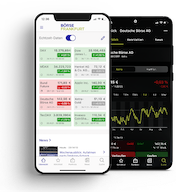Weekly outlook: “Growth and earnings prospects must improve”

After an extremely good year on the stock markets in 2024, caution dominates the first full week of trading in 2025. A wait-and-see approach is the rule ahead of the US labor market figures on Friday - and Trump's inauguration in two weeks' time.
6 January, 2025 FRANKFURT (Frankfurt Stock Exchange). The stock market is back in full swing - after the holidays and the low-volume days of the previous week, the professionals are now back. However, no major jumps are expected before Donald Trump's inauguration on 20th January. It remains to be seen what Trump will make of his announcements, especially with regard to tariffs. Important this week: the US labor market figures on Friday. The market is hoping that these will provide signals about the state of the US economy and future interest rate developments.
The DAX stands at 19,970 points on Monday morning after closing at 19,906 on Friday and just under 20,523 points at its all-time high in mid-December. The US stock markets had made significant gains on Friday after a five-day losing streak.
“DAX already at the upper edge of the fair range”
According to Markus Reinwand from Helaba, the DAX is still moving within its fair range. However, the upper edge of this band, currently at around 21,000 points, is not far away and much of the upside has already been anticipated. Sustainably higher prices can only be achieved if global growth and earnings prospects improve. “In view of the key interest rate cuts in many economies, this is likely to happen in 2025,” says Reinwand. However, after two years of above-average performance, only a moderate increase is expected for the leading international indices in 2025. “The US leading indices in particular, as the most important driver of the global equity market, are already highly valued, which limits the potential.”

LBBW “in the camp of the skeptics”
LBBW is also more cautious with regard to the DAX: “The DAX target of 18,000 points we set a year ago was far exceeded in 2024. For 2025, however, we now find ourselves in the sceptics' camp,” emphasizes Berndt Fernow. The bank is one of the few banks to see a clear risk of a setback for the stock markets. The stock markets have now priced in “the best of all worlds”. The risks of trade or geopolitical tensions caused by the change in Washington are being ignored. “However, as the performance counters are back to zero on New Year's Day, the risk buffers of institutional investors have disappeared,” explains Fernow. This means that the underlying skepticism can quickly dissipate.
Chart technology: “Not too much euphoria”
The charts give no cause for optimism. Ralf Umlauf from Helaba points out that the defense of the 20,000-point mark failed last week. “The indicator picture warns against too much euphoria, as does the fact that the 21-day line has not yet been recaptured,” he explains.
Important economic and business events of the week
Monday, 6 January
14:00. Germany: December consumer prices. Inflation is likely to have picked up slightly last month, according to Deutsche Bank. An average of 2.2 to 2.4 percent is expected. Reason: higher food, energy and fuel prices.
Tuesday, 7 January
11.00 am. Eurozone: December consumer prices. Inflation in the eurozone is likely to have amounted to 2.5 percent in December, explains Commerzbank. On the one hand, petrol and diesel have become more expensive. On the other hand, falling prices in 2023 were excluded from the comparison. For the core rate, the bank forecasts 2.7 percent.
Thursday, 9 January
8.00 am. Germany: Industrial production December. According to DekaBank, industrial production has fallen once again. This is indicated by declines in tolls, VDA automotive and steel production. Nevertheless, the bottom line is an improved result for production in the manufacturing sector, which is probably due to a sharp rise in energy production and an increase in construction output.
Friday, 10 January
14:30. USA: Unemployment figures for December. Special factors such as hurricanes and strikes characterized the months of October and November, according to Commerzbank. A more meaningful indication of the state of the US labour market is probably the average of the two months, i.e. an increase in employment of 132,000. The bank expects an increase of this magnitude for December, specifically 150,000. This is a solid plus, but would continue the trend towards a slower increase in employment.
By Anna-Maria Borse, 6 January, 2025, © Deutsche Börse AG
About the Author
Anna-Maria Borse is a financial and business editor specializing in the financial market/stock exchange and economic topics.
Feedback and questions to redaktion@deutsche-boerse.com





